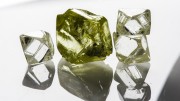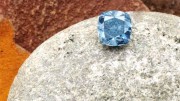China’s rising appetite for diamonds is often the focus of attention for diamond-watchers, but there’s another Asian giant that plays a pivotal role in the market.
Like China, India has a vast consumer market for diamonds, but the country is also a big trading centre for diamonds, and the place where roughly 80% of the world’s diamonds are polished.
During the financial crisis, India was somewhat isolated from the global crash, says Avi Krawitz, an Israel-based senior editor with the Rapaport Group.
“In 2008, when the market crashed, it really gave a boost to the Indian market because they had this domestic consumption there that sort of saved the day (compared to other centres) such as Israel and Belgium, who were relying only on their exports,” Krawitz said in a telephone interview. “So India had this enormous domestic market that kept it afloat and wasn’t feeling the global recession as much.”
After strongly rebounding from 2009 to mid-2011, diamond prices have been on the decline since last summer, dipping about 15% for polished diamonds and 20% for rough.
A lack of overall demand due to economic uncertainty is once again to blame. But this time, India is not in a position to help prop up demand.
The Indian economy is slowing down, and Indian consumers are cutting back on luxury purchases. Rampant inflation, high gold prices, and a weak rupee that has lost about 25% of its value over the past year are further depressing the Indian jewelry market.
Diamond manufacturers in the country are also suffering because contract sellers such as De Beers and Alrosa have restricted supply rather than lower their prices for rough.
“Manufacturing profit margins are non-existent at the moment, because rough prices are high,” Krawitz says.
For diamond prices and Indian manufacturers to gain some stability, more liquidity is needed, says RBC Capital Markets mining analyst Des Kilalea.
“A factor in the stability in rough prices remains the liquidity position in India,” Kilalea wrote in a late September research note. “Levels of liquidity remain tight and it will take time for this market to recover.”
In fact, Krawitz argues the liquidity situation in India today is tougher than it was in 2008.
Back then, the Indian industry halted its rough imports for about a month, helping to ease liquidity challenges and even gain market share over competing countries, Krawitz explains.
Indian diamond manufacturers also had easier access to financing than their competitors because banks in the country have to allocate up to 15% of their funds to export industries at a subsidized rate, and they can easily meet this quota with diamond manufacturers then move to profitable lending, Krawitz adds.
“Today, their liquidity challenges are different and I would say tougher than 2008 since it has prolonged over a longer period,” he said in an email. “India’s liquidity position has been weakened by the volatile rupee, which has also affected consumers’ ability to buy gold and diamond jewelry. In addition, rough prices have been relatively sustained at high levels and Indian manufacturers have continued to buy throughout the downturn. . . bringing additional liquidity pressures.”
Ultimately, liquidity will only return when there’s a pick-up in demand, Kilalea notes.
“The key to a firm floor under rough will be solid year-end world diamond jewelry sales to allow diamantaires liquidity to rebuild inventory,” Kilalea wrote.
“This is only likely in the new year provided diamond jewelry sales are sound over the year-end holidays.”





Be the first to comment on "India to the rescue?"